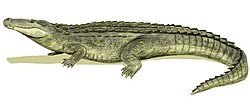| Dollosuchoides Temporal range: Middle Eocene, | |
|---|---|
| Scientific classification | |
| Domain: | Eukaryota |
| Kingdom: | Animalia |
| Phylum: | Chordata |
| Class: | Reptilia |
| Clade: | Archosauria |
| Order: | Crocodilia |
| Superfamily: | Gavialoidea |
| Genus: | † Dollosuchoides Brochu, 2007 |
| Type species | |
| †Dollosuchoides densmorei Brochu, 2007 | |
Dollosuchoides, colloquially known as the Crocodile of Maransart, is an extinct monospecific genus of gavialoid crocodilian, traditionally regarded as a member of the subfamily Tomistominae. Fossils have been found in the Brussels Formation of Maransart, Belgium and date back to the middle Eocene. [2] [3]
The holotype, IRScNB 482, was discovered in 1915 and it was prepared during 1926–1927 by M. Hubert, J. Mehschaert and M. Jean de Kleermaeker, and also in 1927, Louis Dollo had the holotype put on display in the Museum of Natural Sciences and he intended to describe the specimen but he died in 1931 before he was able to describe it and the specimen was eventually referred to Dollosuchus by Swinton (1937) [3] until it was moved to its own genus by Brochu (2007). [2] [4] It is currently housed in the Gand Museum in Belgium.


